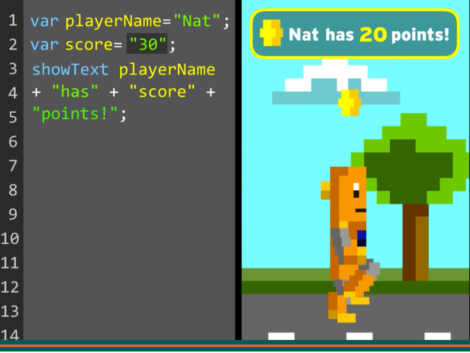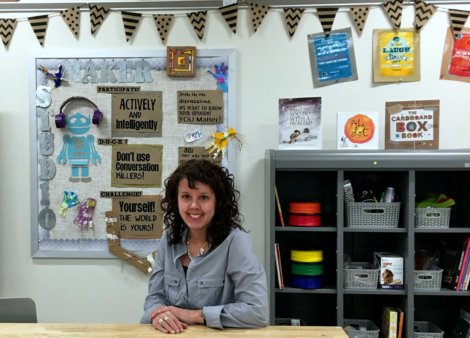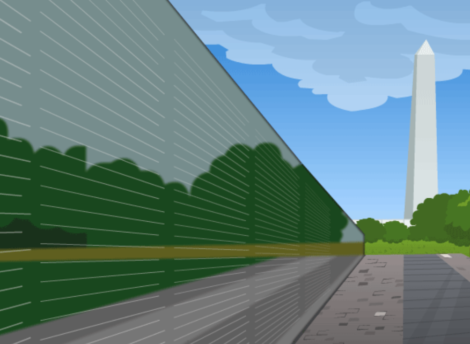
A CBE’s Journey Into Coding
Posted by cemignano on
Guest blogger and Certified BrainPOP Educator Aimee Bloom joins us to share her love of coding and the value she sees in computer science education. Read on to learn how Aimee found her way into Educational Computing and is now using BrainPOP’s Creative Coding with students.
As we are entering my favorite holiday season, Computer Science Week, I thought I would build a little context to my love of coding before I share with you why BrainPOP is a great place to bring CS into your classroom. Hopefully, it will serve as an inspiration for you to spark a love of coding as well.
So it begins in a galaxy far, far, away…
When I was a child, about 8 or so, my father came home with this “souped up” (at least at the time) Commodore 64. He was so excited. I was 8. After about a month or two of tinkering around with this foreign machine, he called me over, sat me down in front of the glowing screen and said to me, “Aimee, you see these words, numbers, and symbols? We’re going to take this set of instructions and you’re going to type them into this c-o-m-p-u-t-e-r and you’ll make a game. It’s called programming.”
So, I naturally did what any good daughter would do. I sat down and opened the book of “programming” (which looked very similar to a phonebook*), typed in the lines of code as prescribed and made my first game – Snake. It didn’t do much by today’s standards of video games, however, it did give me a sense of excitement and wonder as I saw this “code” translate into a game onto the screen.
Meanwhile in a galaxy even farther away, called elementary school, we used the Apple IIe computers to play games like Oregon Trail. I mean don’t get me wrong, I learned a lot about survival; as I either died or was completely thrown off the wagon by my family. Either way, both experiences in my school-aged years of computing made me a resilient adult.
Flash forward to my high school years. I am now a junior who decided to take advertising and design classes at a local occupational center during my afternoons to fulfill my love of art. After a year of attempting to draw straight lines with perfect 90 degree corners, I dropped out. I was bored and personally not engaged. Most of all, embrace yourself, it was way too technical.
I went back to my high school counselor senior year with my arms wide open looking for classes to take to fill up my time. Yes, I took advanced art classes, and physical education every single day, but more importantly for the first time in my school’s history they offered a website and design class. Ironically held by an English teacher. I instantly signed up! This is the year when I re-fell in love with the ability to write code. Code that would transfer web pages into what became a part a of website on this thing called the Internet. As I took this class, I discovered that writing lines of code was another art medium for me. It was my paintbrush and my blank canvas. To me coding is as much about algorithms and mathematical applications as it is about poetry and writing a story.
I started my college endeavor off as an art educator. In an effort to avoid being a “starving artist” I thirsted to learn more about computing and pursued a Master’s degree in Educational Computing. This is where I again took several coding classes and flash animation. My choices in education, as well as being self taught, has afforded me many opportunities to write and create several websites for private schools in my local area. I was finally able to create.
As a teacher I always felt it was important to teach my students how to code. I believe it is a skill that develops and fosters critical thinking skills, creativity, and above all a new means of communication. Teaching students to understand how to ask the right questions to find the information they need to design coding projects is just as vital as understanding syntax and memorizing lines of code. Therefore, I taught my students how to view source code on websites and how to look up code to create what they envisioned; whether it be for a website, game, flash animation, etc. (Hint: right click→ view page source on BrainPOP’s website. You’ll be pleasantly surprised.)
What I love about coding and BrainPOP is that it teaches the students the fundamentals in a platform that is very familiar to them with characters that they love. It provides teachers the opportunity to perhaps step outside their comfort zone and be okay with teaching students how to code, knowing that it is exemplifying what they’re teaching in his or her curriculum.
The Scratch coding within BrainPOP is a wonderful way to start students on fun adventures in coding as it uses block-based programming to teach about the fundamentals of algorithms. Your students can unleash their creativity and computational thinking skills as they develop games, museum exhibits, stories and more. It provides clear directions and instructions that are easy for both educator and student alike.
Vidcode in BrainPOP is another great opportunity for older students to learn how to write lines of JavaScript to tie into your curricular objectives by creating stop animations, newscasts, comics (my fav), and more. This is definitely more challenging as students learn how to type in lines of code opposed to the drag and drop method of Scratch. However, the code is wonderfully taught in a scaffolded manner and is easy to follow and understand. I personally recommend Vicode for 5th grade and up.
Both Vidcode and Scratch afford your students yet another opportunity to creatively express what they have learned during your lesson. It is as much about coding as it is about the content. What an amazing way for a student to create a product that illustrates what they know other than a digital presentation.
My ask of you in December is to be that naive investigator, the ELA teacher who built the plane as it was flying, the risk taker that inspires a student to go beyond consumption and into creation. Help your students find their blank canvas. BrainPOP is a wonderful platform to encourage and embrace this new form of creativity.
*Phonebook- a book comprised of individual and business names, addresses, and phone numbers.Typically free and delivered right to your front door.














